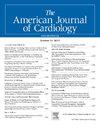双侧乳腺内动脉在糖尿病患者非体外循环冠状动脉移植中的应用。
IF 2.3
3区 医学
Q2 CARDIAC & CARDIOVASCULAR SYSTEMS
引用次数: 0
摘要
由于担心术后并发症,特别是胸骨伤口感染(SWI),双侧乳腺内动脉(BIMA)移植物在糖尿病患者冠状动脉旁路移植术(CABG)中的应用受到限制。然而,BIMA移植联合非体外泵CABG (OPCAB)治疗糖尿病患者的效果仍未得到充分探讨。本研究旨在比较BIMA和单内乳动脉(SIMA)移植在糖尿病OPCAB患者中的效果。对2020年1月至2023年12月行OPCAB合并BIMA或SIMA移植的糖尿病患者进行单中心回顾性分析。基线特征,包括STS风险评分,使用稳定逆概率处理加权(sIPTW)在队列之间进行匹配。本研究纳入412例糖尿病患者:BIMA患者207例(50.2%),SIMA患者205例(49.8%)。在sIPTW匹配后,30天死亡率相同(1.4%,p = .40),深度(0.9% vs. 0.8%, p = .89)和浅表胸骨伤口感染的死亡率相似(4% vs. 1.8%, p = .19)。综合并发症发生率(40% vs 47%;P = .13),各组间肾损伤、再手术出血、卒中、房颤等单项指标相似。总体再入院率和心脏再入院率、出院到急症护理机构的比率以及住院时间超过7天的比率具有可比性。值得注意的是,BIMA的输血率明显较低(31%对40%;P = 0.038)和延长通气时间(9% vs. 16%;p = .033)高于SIMA组。总之,我们的研究结果表明,尽管历史上对伤口愈合并发症的担忧,BIMA移植联合OPCAB可以安全用于糖尿病患者。本文章由计算机程序翻译,如有差异,请以英文原文为准。
Bilateral Internal Mammary Artery in Off-Pump Coronary Artery Grafting in Diabetic Patients
Bilateral internal mammary artery (BIMA) grafts utilization in coronary artery bypass grafting (CABG) for diabetic patients has been limited due to concerns regarding postoperative morbidity, especially sternal wound infections (SWI). However, outcomes for BIMA grafting combined with off-pump CABG (OPCAB) in diabetic patients remain underexplored. This study aimed to compare BIMA and single internal mammary artery (SIMA) grafting outcomes in diabetic OPCAB patients. A single-center retrospective analysis was conducted on diabetes patients who underwent OPCAB with BIMA or SIMA grafts from January 2020 to December 2023. Baseline characteristics, including STS risk scores, were matched between cohorts using stabilized inverse probability treatment weighting (sIPTW). The study included 412 diabetic patients: 207 (50.2%) received BIMA and 205 (49.8%) received SIMA grafts. After sIPTW matching, 30-day mortality was identical (1.4%, p = 0.40), with comparable rates of deep (0.9% vs 0.8%, p = 0.89) and superficial sternal wound infections (4% vs 1.8%, p = 0.19). Composite complication rates (40% vs 47%; p = 0.13) and individual components such as renal injury, reoperation bleeding, stroke, and atrial fibrillation were similar between groups. Rates of overall readmission and cardiac readmission, discharge-to-home versus acute care facilities, and hospital stays longer than 7 days were comparable. Notably, BIMA showed significantly lower rates of blood transfusion (31% vs 40%; p = 0.038) and prolonged ventilation (9% vs 16%; p = 0.033) than SIMA group. In conclusion, our findings suggest that BIMA grafting combined with OPCAB may be safely used in diabetic patients despite historical concern about wound healing complications.
求助全文
通过发布文献求助,成功后即可免费获取论文全文。
去求助
来源期刊

American Journal of Cardiology
医学-心血管系统
CiteScore
4.00
自引率
3.60%
发文量
698
审稿时长
33 days
期刊介绍:
Published 24 times a year, The American Journal of Cardiology® is an independent journal designed for cardiovascular disease specialists and internists with a subspecialty in cardiology throughout the world. AJC is an independent, scientific, peer-reviewed journal of original articles that focus on the practical, clinical approach to the diagnosis and treatment of cardiovascular disease. AJC has one of the fastest acceptance to publication times in Cardiology. Features report on systemic hypertension, methodology, drugs, pacing, arrhythmia, preventive cardiology, congestive heart failure, valvular heart disease, congenital heart disease, and cardiomyopathy. Also included are editorials, readers'' comments, and symposia.
 求助内容:
求助内容: 应助结果提醒方式:
应助结果提醒方式:


